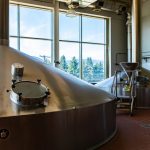
High gravity brewing, also known as “big beer brewing” or “high-alcohol brewing,” refers to the process of brewing beer with a significantly higher original gravity (OG) than traditional brewing methods. Original gravity is a measurement of the sugar content in the wort (unfermented beer) before yeast fermentation begins. By starting with a higher OG, brewers aim to produce beers with a higher alcohol content and more robust flavor profiles.
An overview of the high gravity brewing process
Mashing
Just like in regular brewing, the process begins with mashing, where malted grains (usually barley) are mixed with hot water to convert starches into fermentable sugars. The result is a sugary liquid called wort.
Boiling
The wort is then boiled, and hops are added to provide bitterness, flavor, and aroma to the beer.
Concentrated Wort
In high gravity brewing, instead of boiling the wort down to the typical original gravity (OG) level of around 1.040-1.060, the wort is boiled down to a much higher concentration, typically exceeding an OG of 1.080 or more.
Dilution
After boiling, the concentrated wort is diluted with water to achieve the desired original gravity. This step is crucial because a high OG can stress yeast and affect fermentation. Dilution helps create an environment where yeast can thrive and ferment the sugars effectively.
Fermentation
The diluted wort is cooled and transferred to the fermentation vessel, where yeast is added. The yeast consumes the fermentable sugars, producing alcohol and carbon dioxide. Due to the higher sugar content, fermentation in high gravity brewing might take longer and be more challenging for yeast compared to standard gravity beers.
Aging
Many high gravity beers benefit from extended aging to allow the flavors to mature and harmonize. Some high gravity beers, like barley wines and imperial stouts, can be aged for months or even years to develop complex and mellow flavors.
Bottling or Kegging
Once fermentation and aging are complete, the beer is either bottled or kegged for packaging and distribution.
High gravity brewing allows brewers to create potent and flavorful beers, often with higher alcohol content and richer taste profiles (Erten et al., 2007).
The principal benefits are:-
- improved brewing capacity
- more efficient use of existing plant facilities
- reduced labour and energy costs which also means reduced cleaning and effluent costs
- better physical and flavour stability of the beer
- smoother flavour
- more alcohol per unit of fermentable material i.e. wort because of reduced yeast cell growth,
- higher adjunct rates.
- Increased flexibility around fermentation processes.
However, it requires careful attention to yeast management, fermentation conditions, and aging to achieve the desired balance and complexity in the final product.
The main disadvantages are:
- reduced brewhouse material efficiency
- reduced hop use
- poorer foam stability
- issues with flavour matching
- loss of yeast performance because of higher osmotic pressures and ethanol concentration.
The main methods of resolving any issues around brewing at higher than normal gravity are to:-
- increase fermentation temperatures
- improve oxygen levels during the brewing process
- use higher pitching rates
High gravity beers are often enjoyed in moderation due to their increased alcoholic strength.
References
Erten, H., Tanguler, H., & Cakiroz, H. (2007). The effect of pitching rate on fermentation and flavour compounds in high gravity brewing. Journal of the Institute of Brewing, 113(1), pp. 75-79.

A really useful series. We’re starting up a brewery – no name yet!